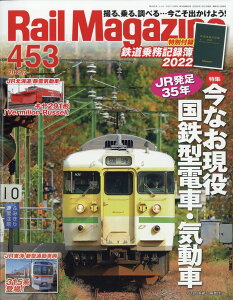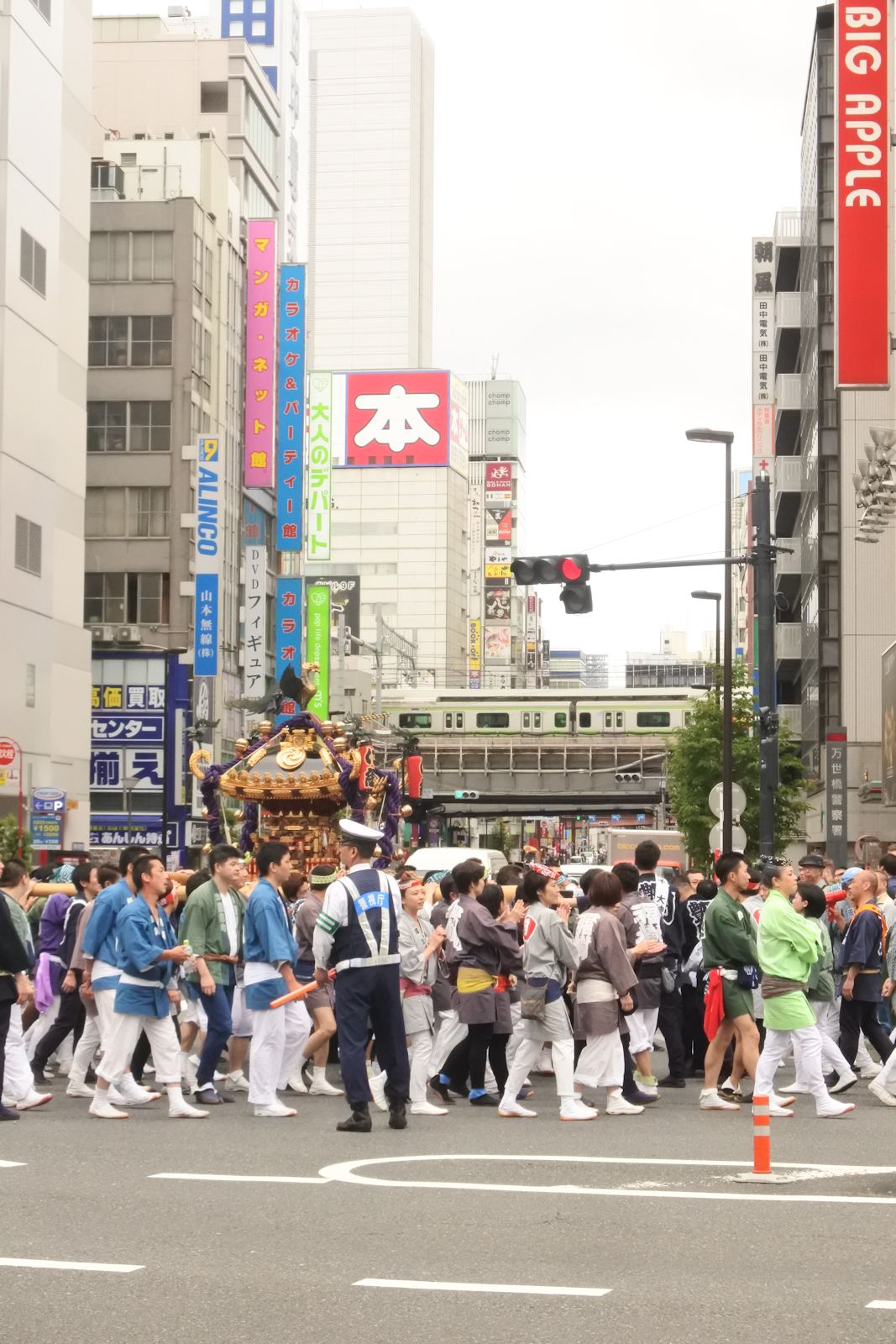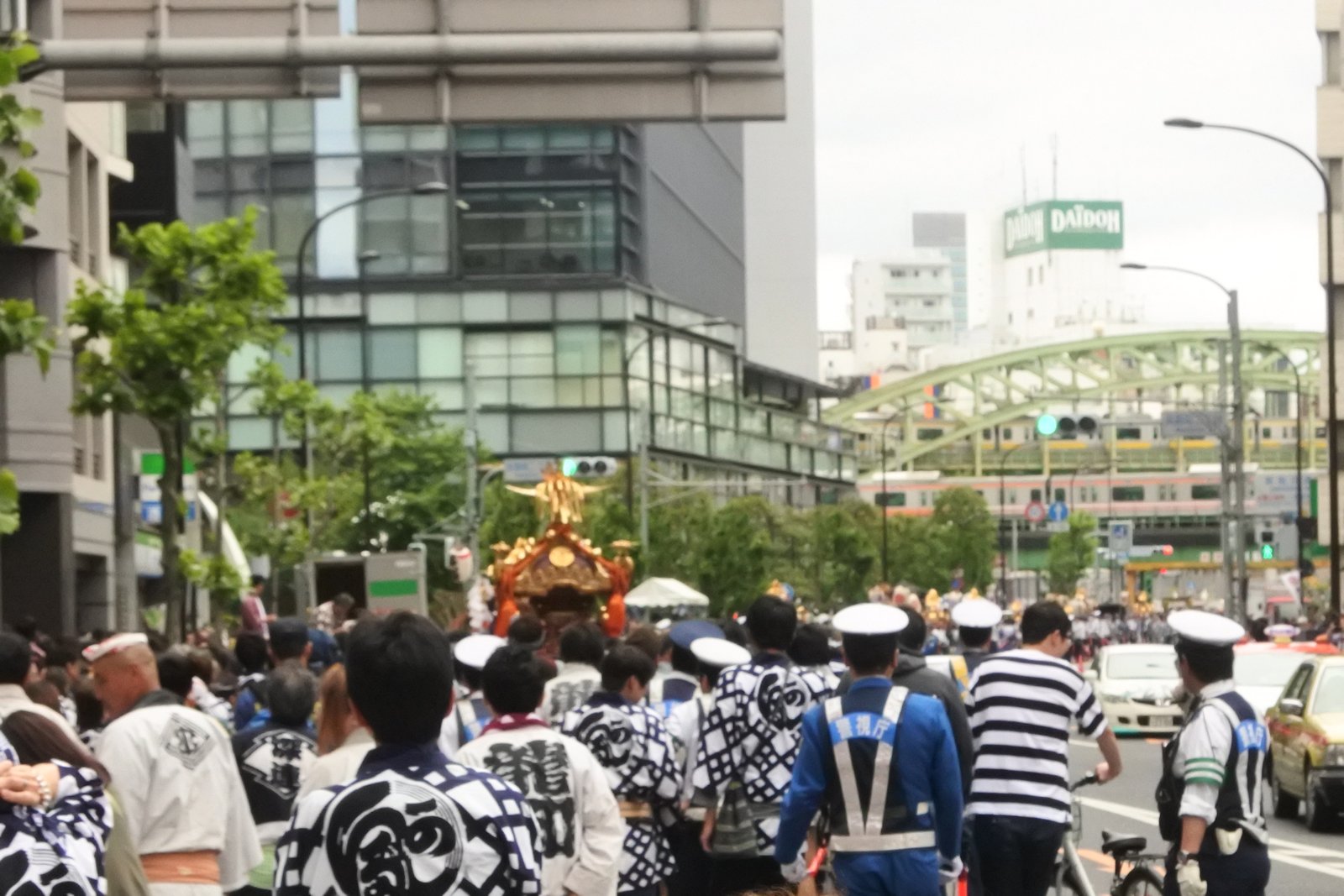PR
X
キーワードサーチ
▼キーワード検索
カレンダー
サイド自由欄
鉄道模型・鉄道グッズリンク
鉄道関連書籍リンク
時刻表最新号
JTB時刻表

JR時刻表

鉄道雑誌最新号
鉄道ファン

鉄道ジャーナル

鉄道ピクトリアル

鉄道ダイヤ情報

Rail Magazine

RM MODELS

j train

とれいん

鉄道模型趣味

N

旅と鉄道

楽天トラベルで旅に出よう

鉄道関連書籍リンク
時刻表最新号
JTB時刻表

JR時刻表

鉄道雑誌最新号
鉄道ファン

鉄道ジャーナル

鉄道ピクトリアル

鉄道ダイヤ情報

Rail Magazine

RM MODELS

j train

とれいん

鉄道模型趣味

N

旅と鉄道

楽天トラベルで旅に出よう
コメント新着
カテゴリ: 街めぐり・神社めぐり
14日、東京・千代田区外神田にある神田明神の神田祭を見に行った。
神田明神は、730(天平2)年に当時の豊島郡芝崎村(千代田区大手町・将門塚周辺)に創建。江戸時代初期の1616(元和2)年に現在の外神田に移転(遷座)、社殿は江戸幕府によって建造された。それ以来、江戸総鎮守として、幕府の役人から江戸庶民まで幅広い人々に詣でられるようになった。明治時代には東京の守護神である「准勅祭社」「東京府社」に定められた。また、商売繁盛の神様として年明けには多くの会社経営者が参拝する姿が見られることでも知られている。
神田祭は神田明神で2年に1度開催される。毎回5月中頃に実施され、今年2017(平成29)年は5月11日~17日の日程で開催された。14日は神社周辺各地区の神輿が神田・秋葉原・日本橋を練り歩く神輿宮入(みこしみやいり)の日。
街中を練り歩く神輿を僕らしい構図で写真が撮れないかと考え、撮り鉄な僕だけに、列車と神輿を共に収めた1枚を撮ってみた。

万世橋交差点より、本郷通りから中央通りへと曲がり万世橋方面へと向かう神輿と秋葉原駅に停車中の山手線列車(車両はE231系) From Manseibashi intersection, mikoshi parading from Hongo Street to Chuo Street and a Yamanote Line train (E231 Series) stopping at Akihabara Station

淡路町交差点付近から昌平橋方面へと練り歩く神輿と中央線快速列車(車両はE233系)と中央・総武緩行線列車(車両はE231系) From Awajicho intersection, mikoshi and Chuo Line rapid service train (E233 Series) and Chuo-sobu Line local service train (E231 Series)
神田祭は僕が東京都民としてぜひとも一度見たかった祭りの1つ。実は前回2015(平成27)年の神田祭を見に行こうと計画を立てていたものの、諸事情により断念。今回初めて祭りの様子を目にした。やはり神輿が街中を練り歩く光景は、日本の祭り特有の荘厳さを感じると同時に、心が清らかになる。
参考文献: 神田明神オフィシャルサイト
On 14th, I went watching mikoshi portable shrines parade of Kanda Festival being held at Kanda Myojin Shrine in Soto-kanda, Chiyoda-ku, Tokyo.
Kanda Myojin Shrine was built in 730, at first located in Otemachi, Chiyoda-ku, at where Masakado-duka is located in the present. In 1616, the early Edo period, the shrine was relocated to Soto-kanda and the new pavilions were built by Tokugawa shogunate. Since then, the shrine had been beloved by many Tokyoites. In addition, on the first business day of every year, many company presidents visit there to pray for prosperity in their business.
The festival is being held every two years and this year was between May 11 and 17th. On that day, many local people carried mikoshi and paraded in Kanda, Akihabara, and Nihonbashi area, which was called "mikoshi miyairi".
I photographed them with trains on Yamanote Line and Chuo Line (rapid service and Chuo-sobu Line local service).
I had been looking forward to watching the festival and planned to do the previous time, but I couldn't go. I saw that mikoshi parade had a solemn characteristic of Japanese festival and it made my mind clear seeing the Shinto Deities in mikoshi nearby.
Because of Sunday, many people visited the shrine and the town around there to watch the festival.
official website of Kanda Myojin Shrine .
神田明神は、730(天平2)年に当時の豊島郡芝崎村(千代田区大手町・将門塚周辺)に創建。江戸時代初期の1616(元和2)年に現在の外神田に移転(遷座)、社殿は江戸幕府によって建造された。それ以来、江戸総鎮守として、幕府の役人から江戸庶民まで幅広い人々に詣でられるようになった。明治時代には東京の守護神である「准勅祭社」「東京府社」に定められた。また、商売繁盛の神様として年明けには多くの会社経営者が参拝する姿が見られることでも知られている。
神田祭は神田明神で2年に1度開催される。毎回5月中頃に実施され、今年2017(平成29)年は5月11日~17日の日程で開催された。14日は神社周辺各地区の神輿が神田・秋葉原・日本橋を練り歩く神輿宮入(みこしみやいり)の日。
街中を練り歩く神輿を僕らしい構図で写真が撮れないかと考え、撮り鉄な僕だけに、列車と神輿を共に収めた1枚を撮ってみた。

万世橋交差点より、本郷通りから中央通りへと曲がり万世橋方面へと向かう神輿と秋葉原駅に停車中の山手線列車(車両はE231系) From Manseibashi intersection, mikoshi parading from Hongo Street to Chuo Street and a Yamanote Line train (E231 Series) stopping at Akihabara Station

淡路町交差点付近から昌平橋方面へと練り歩く神輿と中央線快速列車(車両はE233系)と中央・総武緩行線列車(車両はE231系) From Awajicho intersection, mikoshi and Chuo Line rapid service train (E233 Series) and Chuo-sobu Line local service train (E231 Series)
神田祭は僕が東京都民としてぜひとも一度見たかった祭りの1つ。実は前回2015(平成27)年の神田祭を見に行こうと計画を立てていたものの、諸事情により断念。今回初めて祭りの様子を目にした。やはり神輿が街中を練り歩く光景は、日本の祭り特有の荘厳さを感じると同時に、心が清らかになる。
参考文献: 神田明神オフィシャルサイト
On 14th, I went watching mikoshi portable shrines parade of Kanda Festival being held at Kanda Myojin Shrine in Soto-kanda, Chiyoda-ku, Tokyo.
Kanda Myojin Shrine was built in 730, at first located in Otemachi, Chiyoda-ku, at where Masakado-duka is located in the present. In 1616, the early Edo period, the shrine was relocated to Soto-kanda and the new pavilions were built by Tokugawa shogunate. Since then, the shrine had been beloved by many Tokyoites. In addition, on the first business day of every year, many company presidents visit there to pray for prosperity in their business.
The festival is being held every two years and this year was between May 11 and 17th. On that day, many local people carried mikoshi and paraded in Kanda, Akihabara, and Nihonbashi area, which was called "mikoshi miyairi".
I photographed them with trains on Yamanote Line and Chuo Line (rapid service and Chuo-sobu Line local service).
I had been looking forward to watching the festival and planned to do the previous time, but I couldn't go. I saw that mikoshi parade had a solemn characteristic of Japanese festival and it made my mind clear seeing the Shinto Deities in mikoshi nearby.
Because of Sunday, many people visited the shrine and the town around there to watch the festival.
official website of Kanda Myojin Shrine .
お気に入りの記事を「いいね!」で応援しよう
[街めぐり・神社めぐり] カテゴリの最新記事
-
箱根海賊船・芦ノ湖遊覧船と平和の鳥居 Mar 15, 2020
-
21年ぶりの北海道 函館の夜景を眺める Sep 14, 2019
-
花見の「静岡デスティネーションキャンペ… Apr 13, 2019
【毎日開催】
15記事にいいね!で1ポイント
10秒滞在
いいね!
--
/
--
© Rakuten Group, Inc.








